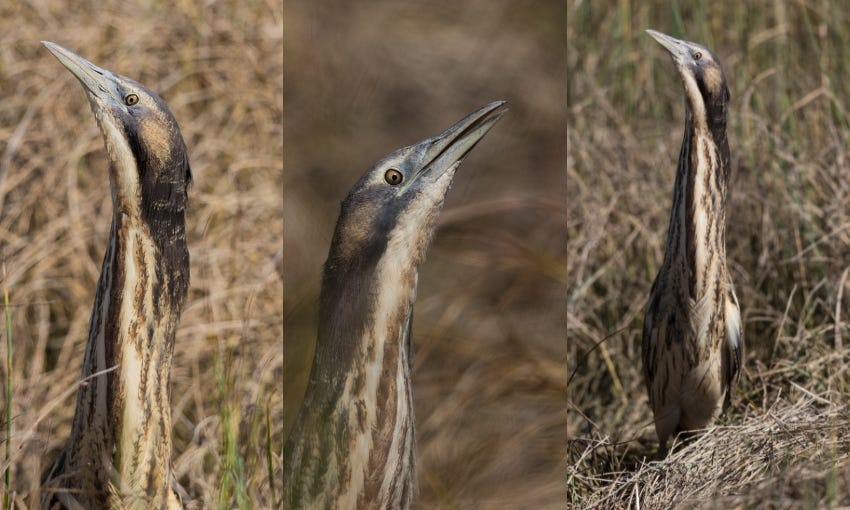These boomers are not OK
A project wants more people to get ‘bittern’ by the matuku hūrepo bug.
Kia ora! Welcome to Future Proof. Thanks for joining me. This edition: pollution charges get more kids active, and why we all love Moo Deng the hippo. But first: it’s time to get smitten with bittern.
Matuku hūrepo pretending to be reeds. Images credit: Imogen Warren.
Wendy Ambury calls him Te-rangi, the matuku hūrepo Australasian bittern who lives near her. She will go down to the reeds where he booms. “He suns himself and he just stands there looking at me. And I just stand there looking at him,” she says. She misses him when she’s away.
Ambury’s relationship with Te-rangi is unusual. Matuku hūrepo are typically secretive birds, hiding away in dense raupō reeds. I’ve only ever seen one with my own eyes, despite spending two years working on a New Zealand Geographic feature about them.
They’re large birds, but artfully camouflaged in their wetland homes. You’re more likely to hear a bittern than see it – specifically, the male bittern, who makes a deep whoom call at dusk this time of year. It’s a “magical noise” that Ambury encountered as a child in the wetland near her home. “I would tell my siblings the noise was a swamp monster,” she says.
With wetlands drained and degraded, the bittern’s booms have been dwindling across Aotearoa. The species is now considered “Nationally Critical” – just one step away from extinction. We think there are fewer than 1,000 left, but the population picture is murky.
Ambury hopes that getting New Zealanders tuned in to the bittern’s bassy booms will enable a more accurate estimate of bittern numbers. She has organised the Matuku Muster, a citizen science effort to count as many bittern booms as possible across the country over three springtime evenings.
The first, in mid-September, was hampered by “crud” weather. But the most important boom-count night is coming up on 19 October, when most male bitterns will have settled in a territory and will be booming hard.
By listening all on the same night, you avoid double-counting. Bitterns can be remarkably mobile, flying tens or hundreds of kilometres between wetlands – meaning you can never be sure that my booming bittern isn’t the same as yours, unless we’re listening at the same time.
Taking part in the Matuku Muster is easy. Simply find a good spot on the edge of a wetland (Ambury can help find one near you), pull up a deck chair half an hour before sunset, and record the booms you hear on the app. “If you're close enough, you can feel it coming through the ground, and you can see the reeds wriggling before the sound actually hits your ears,” she says.
Repeating this survey far and wide and every year will build a more accurate picture of how matuku hūrepo are faring, Ambury hopes. She’s also hoping to get more folks across Aotearoa aware of their plight, and connected with wetlands. Through her Love Bittern project she’s on a “nationwide crusade”, travelling the country in her bittern van to deliver workshops and empower communities to take action.
When she comes home to Ngunguru in Te Tai Tokerau, Te-rangi is waiting. “I first met him when he was at least two years old and then I’ve been with him for five years,” she says. “I can see he’s ageing. His feathers are going ghostly white.”
Join The Spinoff Members
"Happy to be alive, proud to be a member. Keep up the good work." - Neera, Spinoff member
If you value our work and want to support us, please consider becoming a member today. Already a member? Thank you!
Skiing on melting mountains
Mountains are a big part of New Zealand’s identity, where snow and ice are the foundation for some of our favourite outdoor pastimes. But accessing these remote winter wonderlands often requires high-carbon transport. How are skiers and mountaineers dealing with the climate-fuelled melting of their natural playgrounds? Shanti Mathias finds out what our snowsports community is doing in the face of big climate changes.
London’s charges for polluting cars yield unexpected benefit
In 2019, London established an ultra-low emissions zone where drivers must pay to use vehicles that don’t meet pollution standards. It turns out the zone didn’t just reduce air pollution – it also got more kids biking, walking and scootering to school, according to a new study. Two out of five kids in the study shifted from being chauffeured by their parents to active modes of transport – but whether that’s because parents wanted to avoid pollution charges, or because fewer cars on the road made walking and cycling safer, is unclear.
Another way to get more people moving? Build a connected cycleway network. The Spinoff’s Joel McManus has mapped Wellington’s past, present and future cycleways. The growth is striking.
AI a ‘game changer’ for climate misinformation
Generative artificial intelligence (AI) tools like ChatGPT and Bard are spewing forth false narratives and misinformation, including climate misinformation, DeSmog reports. Some researchers are worried about the volume and persuasiveness of climate mis- or disinformation that could be generated using AI tools, but others say it’s too early to tell how big the problem might be.
Meanwhile, the staggering environmental impacts of AI itself continue to make headlines: The Guardian reports that carbon emissions from in-house data centres may be 662% greater than claimed by big tech. And in a compelling interactive, The Washington Post breaks down how much water and electricity is used up by a ChatGPT prompt to write a 100-word email.
More stories
Is New Zealand stumping up its fair share of global climate funding? Shanti Mathias investigates. (The Spinoff)
This map shows how close your hood is to being a 15-minute city with amenities accessible via walking, cycling or public transport. (Sony Computer Science Laboratories)
These maps show New Zealand’s warmer and wetter future, Newsroom’s Marc Daalder reports.
How floating solar panels on wastewater ponds could help solve New Zealand’s electricity crisis. (The Conversation)
AI-powered weed-killing robots could reduce the need for chemical herbicide sprays by as much as 90%. (Bloomberg)
Antarctic krill are the unsung carbon-storing heroes of the ocean, with sequestration superpowers equivalent to the world’s mangroves, new research finds. (Cosmos)
The simple Japanese fridge organisation method to reduce food waste. (BBC)
Googly eyes and human names make wonky fruit and veg more appealing to shoppers. (Grist)
A quarry in South Waikato seeks to fast-track expansion onto a protected maunga. RNZ’s Farah Hancock explains why this decision could have far-reaching consequences.
She has her own Wikipedia page and livestream at just a couple of months old. She is the moment. She’s Moo Deng the pygmy hippo. There’s a scientific explanation for why we find Moo Deng so downright adorable, The Washington Post explains. Basically, her cuteness is hijacking the evolutionary wiring of our brains.
Hippo hooray,
Ellen
Future Proof is looking for a sponsor!
Connect your brand with an insightful exploration of environmental news, reaching influential readers committed to sustainability and staying informed about the state of our natural world. Contact commercial@thespinoff.co.nz to learn more.
Got some feedback about Future Proof or topics you’d like covered? Get in touch with me at futureproof@thespinoff.co.nz












Loved the title but "Hippo Hooray" is pushing the boundaries a little!
Thanks for the newsletter.
Haha- came here to defend my particular subset of boomers, then stayed for the content. Well done!